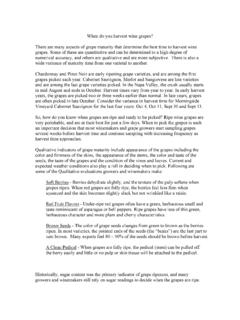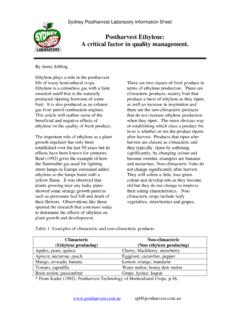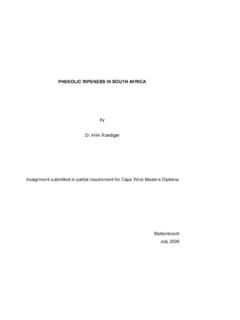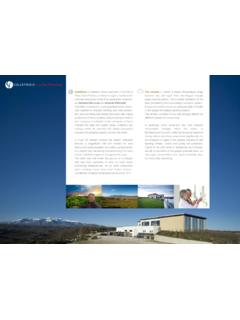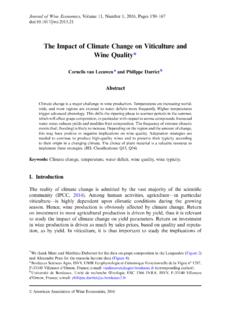Transcription of GRAPE - Food and Agriculture Organization
1 GRAPEPost-harvest Operations - Post-harvest CompendiumGRAPE: Post-harvest Operations Authors: Fabio Mencarelli, Andrea Bellincontro LAPO, Department of Food Science and Technology, University of Viterbo, Italy. Email: Giancarlo DiRenzo Technical Economic Department, University of Basilicata, Italy. E-mail: Edited by: Danilo Mej a, PhD - Agricultural and Food Engineering Technologies Service (AGST) Last reviewed: 13/11/2005 Contents 1 1. Introduction .. 2 Economic and Social impact of the table grapes .. 7 World Table GRAPE Situation and Outlook .. 8 Primary product (fresh) .. 11 Secondary product (processed) .. 14 Postharvest Physiology and Technology Requirements .. 21 Export Quality Assurance .. 22 2. Postharvest 25 Harvest .. 25 Packinghouse (shed) operations .. 27 Shipping.
2 36 Pest 37 References .. 40 Preface GRAPE is one of the most diffuse fruit in the world both as fresh fruit (table GRAPE ) and processed in wine, GRAPE juice, molassa, and raisins. The reason to have these different processed products depends on the extreme perishability of the fruit. As fresh fruit, grapes are very delicate and the loss at harvest and during the distribution is very high. In a survey on postharvest losses on the New York and Chicago markets, Cappellini and Ceponis (1984) reported that on the retail the loss of GRAPE Emperor and Thompson Seedless was respectively of and millions of pounds. The situation is not changed with the years and today table grapes is one the commodity with the higher loss in the retail step of the distribution channel, losses due mainly to shattering and grey mould. If the situation is so critical in term of losses in the Developed Countries, in the Developing Countries the losses are always higher because harvest and postharvest operations to protect grapes from mechanical damage are very poor or completely absent.
3 In Developed Countries table GRAPE is one of the fruit with the highest input of technology (cooling, sulfuration, packing, cold storage) and practices (hand labour). In Developing Countries the cost of labour is low but GRAPE : Post Harvest Operations Page 2 the financial situation to afford the purchase of the equipments sometime is critical. Today, in the direction of market-oriented production even for poor countries, the need of knowledge of advanced technologies as well as the information about the Developed Countries requirements in term of trade quality and safety is very worthwhile. 1. Introduction a) Taxonomy, cultivars grapes belong to the Vitaceae family. The genus Vitis is largely distributed between 25 and 50 N latitude in Europe, the Middle East, North America, and eastern Asia. Additionally, a few species of Vitis are found in the tropics Central American countries, Caribbean, and northern South America.
4 These are over 100 species in the literature, 65 of which are thought to be pure lines and another 44, probably interspecific hybrids. The genus Vitis is divided into 2 subgenera: 1. Euvitis - "True grapes "; characterized by elongated clusters of fruit with berries adhering to stems at maturity, forked tendrils, diaphragms in pith at nodes. Also called "bunch grapes " . Most of the species is in this subgenera. 2. Muscadinia - Muscadine grapes ; characterized by small fruit clusters, thick-skinned fruit, berries that detach one-by-one as they mature, simple tendrils, and the lack of diaphragms in pith at nodes. There are only 2-3 species in this section. b) Origin, history of cultivation Figure 1. Table GRAPE producing areas 1. V. vinifera. "Old world GRAPE ", "European GRAPE ". This is the major species of GRAPE , accounting for >90% of world production.
5 Probably native in the area near the Caspian sea, in Asia Minor. Seeds have been found in excavated dwellings of the Bronze-age in south-central Europe (3500 - 1000 BC). Egyptian hieroglyphics detail the culture of grapes in 2440 BC. The Phoenicians carried wine varieties to Greece, Rome, and southern France before 600 BC, and Romans spread the GRAPE throughout Europe. grapes moved to the far east via traders from Persia and India. Shiraz variety very famous for wine production gets the name from one the most important Iranian city where the grapes were found about 5000 years ago. GRAPE : Post Harvest Operations Page 3 2. V. labrusca. (syn. V. labruscana Bailey). American bunch GRAPE , Fox GRAPE , Concord GRAPE . Valuable in breeding; hybrids used in wine production or as phylloxera resistant rootstocks for vinifera grapes .
6 Major use is for sweet GRAPE juice (Welch's) and associated products - jelly, jam, preserves, some wine. This species is found growing wild from Maine to the South Carolina Piedmont, as far west as the Tennessee mountains. It is thought that Viking explorers, before Columbus' voyages, named the maritime provinces of Canada "Vinland" meaning " GRAPE land" due to the abundance of wild grapes growing in the forests. 3. V. rotundifolia. Cultivated muscadine grapes charcaterised by fruity aroma, thick-skinned berries, in small clusters or borne singly, resistant to Pierce's disease and phylloxera. Native from Virginia in the north through central Florida, west to eastern Texas. c) Botanical description Plant: a liana or woody vine. Leaves are often large (8-10" in width) sometimes deeply lobed as in many V. vinifera cultivars, or rounded with entire or serrate margins.
7 Tendrils occur opposite leaves at nodes. Figure 2. Typical grapes leaves shape Flower: Flowers are small (1/8 inch), indiscrete, 5-merous, borne in racemose panicles opposite leaves on current season's growth. The calyptra, or cap is the corolla, which abscises at the base of the flower and pops off at anthesis. Species in Euvitis may have more than 100 flowers per inflorescence, whereas muscadine grapes have only 10-30 flowers per cluster. Also, vinifera and concord grapes are perfect-flowered and self-fruitful, whereas some muscadines have only pistillate flowers. Figure 3. Inflorescence (left) and young leaves with closed floral buds Pollination: Most grapes are self-fruitful and do not require pollinizers; however, pistillate muscadines ( , 'Fry', 'Higgins', 'Jumbo') must be inter-planted with perfect-flowered GRAPE : Post Harvest Operations Page 4 cultivars for fruit set.
8 Since parthenocarpy doesn't exist, all grapes require pollination for fruit set. Even seedless cultivars like 'Thompson Seedless' are not parthenocarpic; rather, the embryos abort shortly after fruit set. This condition is called "Stenospermocarpy". Fruit: Fruit are berries, with 2 to 4 seeds; ovaries contain 2 locules each with 2 varieties and French-American hybrids may set 4-5 clusters of fruit per shoot, and require cluster thinning for development of quality and proper vine vigor. Fruit size and cluster length are increased through GA application on 'Thompson Seedless' and other table cultivars. GA is applied 10-15 ppm when 50% of flowers on 50% of clusters are in bloom, followed by 40 ppm sizing spray 1 ( 2) weeks later. This opens the cluster, prevents crushing of berries, and reduces disease. Figure 4. grapes bunches of red and white varieties d) General Culture Soils: grapes are adapted to a wide variety of soil conditions, from high pH and salt, to acidic and clay.
9 Rootstocks allow adaptation to various soil situations. In the case of wine production, deep, well-drained, light textured soils are preferable. Highly fertile soils are unsuited to high quality wine production. Irrigation is not always necessary for wine grapes , but is beneficial for table and raisin grapes where high yields are desired. Climate: Vinifera grapes can be generally characterized as requiring a long growing season, relatively high summer temperatures, low humidity, a ripening season free of rainfall, and mild winter temperatures. All of these attributes are found in mediterranean climates. Concord and muscadine grapes are obviously adapted to humid, temperate climates, with muscadines requiring longer growing seasons and milder winters than concords. Cold hardiness is a major limiting factor for vinifera grapes .
10 Damage to primary buds occurs at -18 to -23 C, and trunks may be injured or killed below 23 C. Labrusca grapes are more cold resistant than vinifera or French-American hybrids, but can be injuried between -23 and -29 C. Muscadine grapes are the least cold resistant, being killed below -18 The number of days from bloom to maturity, or heat unit requirement increases as follows: Labrusca (least) < French-American hybrids < European < Muscadine. This generally corresponds to 150-200+ frost-free days, with 165 to 180 best for vinifera, or 2000 to 3500 heat is another limiting factor for vinifera GRAPE culture, due to disease susceptibility. grapes cannot tolerate high RH or rain during harvest. Muscadines, however, GRAPE : Post Harvest Operations Page 5 grow much better in humid requirement is highly variable among GRAPE species; some grapes can be grown in the tropics.










